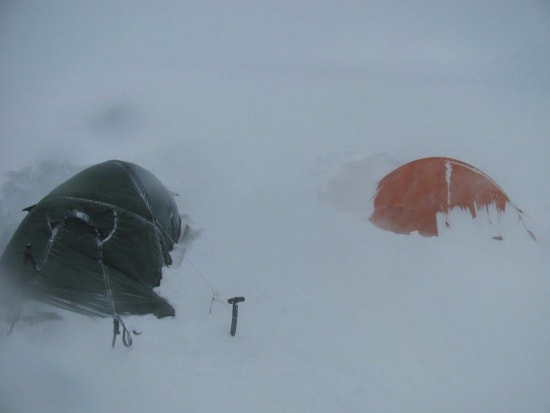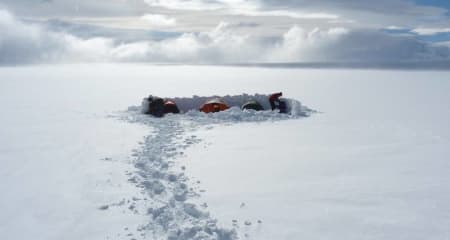Sometimes a basic snow wall is not sufficient to keep the elements at bay. The wind can drop spindrift on the leeward side thus burying the tents. Is there a solution in the way we can construct snow walls that would make them more efficient?
I asked this question on the Worldwide Expedition professional group on LinkedIn

Hastily erected snow walls
}_Last year on the Patagonian Icecap we built snow walls as normal. In high winds spindrift gets dumped on the leeward side when the wind hits irregularities in the surface ie snow walls. This gave another problem in that we had good snow walls but the tents behind them got buried! Do you think there is any way the shape or construction of the wall can be improved to eliminate this occurrence? I ask this as I am heading for a rematch in Patagonia in November 2011! _
Thanks to the respondents and their excellent suggestions.
Damien Gildea • Richard, I had this problem once at high camp on Vinson. A 3-day storm blew in a lot of new snow and half-buried our VE25, needing lots of digging and a broken pole. I think it might help if you build the wall not so flat to the wind, with more of a V shape, or a U shape, so that the wind blows around the wall more, taking the snow with it, rather than just hitting it flat and dumping its load on your tent. I think it's also good to make the wall at least as high as the tent, not the same or lower.
Stuart Remensnyder • no doubt shape is a huge factor along with height but something we had good luck with on Denali was a second lower wall in front of the main wall. The biggest mistake we made was taking over and abandoned "dug-in" site which filled in rapidly and we had to dig out in the am from drift snow only. from then on we always set up on a level the same as the main snowpack. good luck in November!
Tim Vogel • I like Stuarts method it tends to help with less snow behind the wall by lessening the eddy foot print (kayak talk) also try tapering the wall back to improve the flow over the wall.
Simon Garrod • Hi Richard, I would agree with the comments so far. I tend to make walls as aerodynamic as possible so the wind flows around them and is therefore less likely to lose momentum and dump snow. I therefore make them curved rather than straight and also back fill the windward (front face) to make an angled slope. This potentially creates less buffeting and hopefully keeps the snow moving. It also reduces the risk of scouring between the snow blocks with prolonged stays and reduces the risk of blocks being blown off and hitting the tent. I had this happen once in a 80 knot plus blow and it ended up breaking my tent partners ribs. My philosophy with walls is that I would rather shovel than have my tent destroyed by the wind, even if they can be a pain to build and maintain! A different tack would be to build lower walls and double pole the tents - just a thought.
Werner Berger • My three climbs on Denali concur fully with the comments made by Simon Garrod. V-shaped walls with packed snow on the windward side, angling to the top and about 6" to 12" higher than the tent allows the snow to fly over and get dumped on the downwind side of the tent.
Dave Hartman BS EMTP I/C • I would suggest that you review some basic concepts. First, and foremost, any time you change the velocity of wind, you alter it's ability to carry snow. The deflection upwards creates a vacuum behind the wall. This causes an eddy which tends to rotate. This causes it to drop it's velocity i.e. load. This is why you get cornices. It's also why airplane wings ice up.
The reason the windward side is always cleaner is that the velocity increase can carry more,, thus "scrubs" the ground clean.
I'm not too certain that you can shelter a site and still not have it fill in with drift. Having said that, think about natural areas that are sheltered, and at the same time not drifted. If you can maintain the wind velocity over your site and not create turbulence on the lee you'll be cleaner. (that's why an igloo doesn't accumulate very much). Either a secondary wall on the leeward side to maintain the wind velocity, or positioning your site directly before a negative slope change might work.
I would think combining Werner an Simon's method of a smooth angled windward wall,, then a secondary leeward structure to minimize turbulence will work best.
Interesting problem! I'll do some playing around and let the group know what I find. I'm teaching a mountaineering SAR class next month. I'll turn my students loose on it and see what they come up with. Thanks!!
Stuart Remensnyder • Below is something technical on snow drifting with a number of interesting conclusions including:
"Scalemodel tests by Sherwood (1967a) in the NCEL wind duct have shown that the rate of drift accumulation around the types of at-grade polar buildings at present in use can be reduced by orienting them 45 degrees to the storm wind. These tests have also shown that buildings elevated on solid platforms 2 to 4 feet above the surrounding surface have much less drift than when directly on the surface."
Dave - If would be great if you can all take some measurements and pics and report back to us!
here is the link to the download pubs.aina.ucalgary.ca/arctic/Arctic22-2-112.pdf
Snow Movement- Drift Control forSurface (At-Grade) Camps N. S. STEHLEl ABSTRACT. Snow movement in polar areas creates problems for surface (at-grade) camps,particularlyinareas of net annual snow accumulation. Snowdriftstudies, which were made over a 4-year period around a single unprotected building and around a cluster of buildings in an area of net annual snow accumulation on the Ross Ice Shelf near McMurdo Station, Antarctica, showed that at-grade camps will eventually becomecovered with drifting snow. Driftcontrol measures, however, can be used to increase the usefulness and life of such camps. The measures devel- oped cover proper building orientation and camp layout with respect to the major storm winds. In addition, mobile foundations may be used for buildings to facilitate camp moves when snowdrift becomes excessive.
Dave Hartman BS EMTP I/C • It's funny,, the more you look at this, the more involved it becomes! I'm looking forward to seeing what my students come up with. Since they're engineers I suspect they'll beat it to death. We'll take pictures and measurements. I wouldn't be surprised to find there's a master's thesis in there somewhere! I'll report back.
Richard Hartley • Any news on what the students have come up with Dave? I tried v shaped walls and a smaller windward pre wall on the Icecap a few weeks ago. Partly successful but still had some spindrift over the tents. Unfortunately, we were blessed by 3 days of unheard of (in Patagonia anyway) windless and sunny days so werent able to try out slightly differing alternatives. Too tired to take measurements, sorry getting old!
